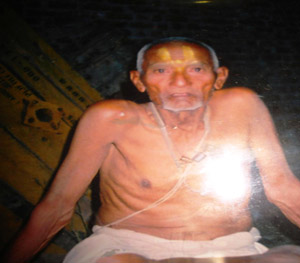
Baba Baikal Das
Even as a seventy-year old, Baikal baba cut a striking figure. His age had not detracted from his strong and wiry build. A yellow sandal tilak adorned his copper-complexioned visage. More often than not he sported a white kurta and knee-length dhoti. A metal vessel used to double up as a kamandal in his hand even as his eyes gleamed with a rare spiritual spark.
Baba was also known as Swami Narayan Das and Bhangar Baba amongst his devotees in different parts of India. This great seer and teacher was born in a farming family of Paderi village, situated on the banks of the river Kane in Uttar Pradesh.
Baikal Baba was merely eight years old when his guru initiated him into the Ram mantra. At this young age, Baba took a vow of celibacy which he was to observe for the rest of his life. However, his accounts of his initiation and his time spent with his Guru as he narrated to his disciples seem to follow a non-linear time line. His own guru was the great Tapa Baba of Tapapur in Ayodhya district-a site that is remarkable for its spiritual significance amongst initiated devotees of this order. Apparently Baikal Baba is affiliated to Badi Jagah of Ayodhya.
In his youth, in order to help his family, Baba left his home to work in the collieries in Bengal. During his stay here he received spiritual guidance from various Masters from time to time. One such Master was an old Sadhvi, an adept in Vaishanv Tantrism, whom Baikal Baba often remembered. There he became a union leader and actively participated in the Indian freedom struggle. He also earned fame as a wrestler and was an earnest devotee of Lord Hanuman. Indeed it was after defeating a renowned wrestler much stronger than himself that Baikal Baba surrendered completely to Bajrangbali. With the money he won in the bout, he got a pet elephant named Laxmi, and constructed a grand Hanuman temple in Asansol (Bengal) before finally renouncing the world. He left the place shortly after.
What followed was a period of twenty years that were spent in wandering all over the country. Finally, he reached Kanpur in the late-sixties where he finally decided to settle down. A large number of people from different communities visited him daily to get their problems sorted out. Each day was filled with miraculous recoveries of people suffering from physical, mental or any other problems. Baba gave them literally anything he had at hand- fruit, cloves, herb, medicine, camphor, ash, dust- and it worked without fail. He cured people out of their death-beds miles away merely through his will.
This great sage was really not attached to material possessions. He would give away new clothes or shoes as soon as he got them. Baba neither asked anyone for food nor cooked it himself; he entirely depended on the Divine to take care of him. He never let his disciples construct permanent walls or roof at his place; whatever the season he was under the sky. Baba was entirely unpredictable; he’d be laying down one moment and the next moment adjusting his shoes and kamandal to go somewhere. One afternoon in the scorching heat of June, someone came to him but he wasn’t in his usual place. The person found Baba sitting on the highway at some distance and asked- “Why are you sitting here? It is so hot let’s go back.” Baba replied-“I like the wind on my face when trucks speed by. Go away.”
His sole concern was the transcendental level of consciousness. He belonged to the ancient, mystical and powerful siddh tradition of yogis of Ayodhya. A small minority of people amongst his devotees also graduated to seeking actual spiritual instruction. To some people, Baba seemed to be a living incarnation of Lord Hanuman. Baba used to respond to both praise and criticism with the same equanimity. He really was humility personified.
He never wrote anything, nor gave sermons or preached. Through their interactions with him, some of his disciples wrote whatever he uttered in transcendental state. With his permission, it was published as book titled ‘Mahavigyan’. In Baba’s own words, one leaf of the book per day would suffice.
Baikal Baba finally left for his heavenly abode on the 6th of February, 2001. Once free from his physical body, Baba said he’d be like an unsheathed sword. His Samadhi is built at Paderi, the place where he was born. A temple commemorating his great spiritual achievements has been built at the place where he lived in Kanpur .Even after having left his body; Baba’s benevolent presence was felt by his many devotees. Ceremonies and Bhandara (feasts open to all) are organized at Paderi and Kanpur on important dates. Prominent celebrations are held for Mahashivaratri and Nagapanchami i.e. His birthday at Kanpur, and His Punyatithi on trayodashi of Shuklpaksh Magh at Paderi. Annual pilgrimage to Tapapur is undertaken during Chait Navratri. Yajna and worship is organized for other important dates in Hindu calendar such as Diwali, Holi, Janmashtami etc at Kanpur.